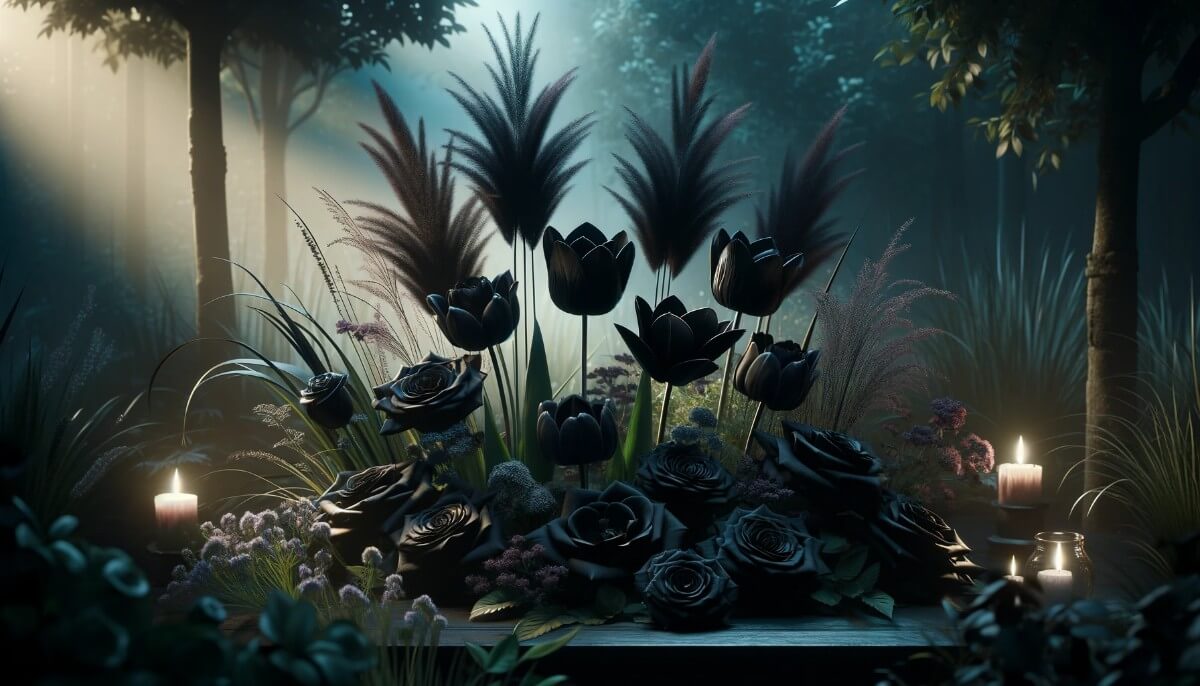Embark on a floral odyssey through the alphabet, starting with the letter ‘A’. From the Angelonia’s fragrant spires to the Azalea’s vibrant blooms, we’ll explore a world where the African Daisy and the Asiatic Lily reign. These flowers, each beginning with ‘A’, offer a diverse array of colors, shapes, and scents, painting our gardens with nature’s own initials. Join us as we celebrate the botanical beauty and rich variety of these remarkable blossoms.
A Blossom Beginning: The ‘A’ List of Flowers
Amaryllis: The Winter’s Colorful Herald
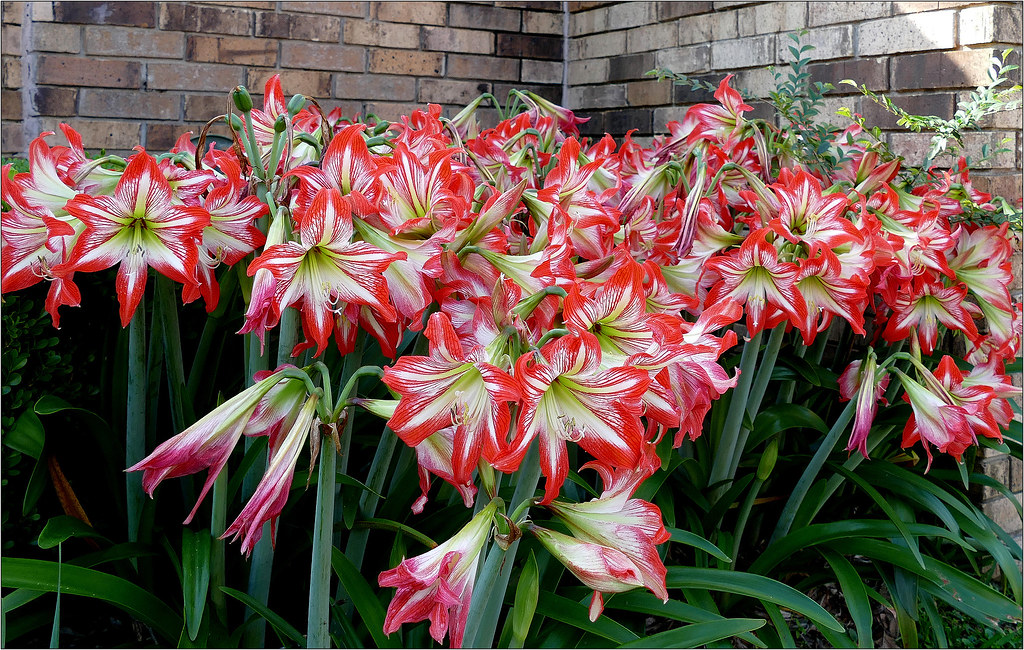
Amaryllis, a genus comprising the striking Hippeastrum spp., offers some of the most vibrant and showy blooms to grace the indoor winter environment. Originally hailing from the lush landscapes of South America, these flowers have become a beloved feature in homes around the world, especially during the cooler months when their bold colors can enliven any space.
The blooms of the Amaryllis are large and trumpet-shaped, often appearing in clusters atop tall, sturdy stalks. Their colors range from the purest whites to the deepest reds, with many varieties showcasing stripes or edges in contrasting hues. It is the Amaryllis’ impressive size and bright palette that make it a favorite for holiday decoration and a cherished gift during the winter and spring seasons.
| Family | Appearance | Origin | Blooming Season | Growth Habit | Size |
| Amaryllidaceae | Large, showy blooms with vibrant colors. | South America | Winter-Spring | Bulb | 1.5-2.5 ft tall |
Growing Amaryllis is a rewarding pursuit, often beginning with a dormant bulb that awakens to life indoors. These plants prefer bright, indirect light and well-drained soil, with careful watering that encourages but does not overwhelm the developing stalks and blooms.
Once the flowering period is over, with the right care, the bulb can be encouraged to enter a period of dormancy before being prompted to bloom again, bringing its striking beauty back into the home year after year.
Aster: The Autumnal Starburst
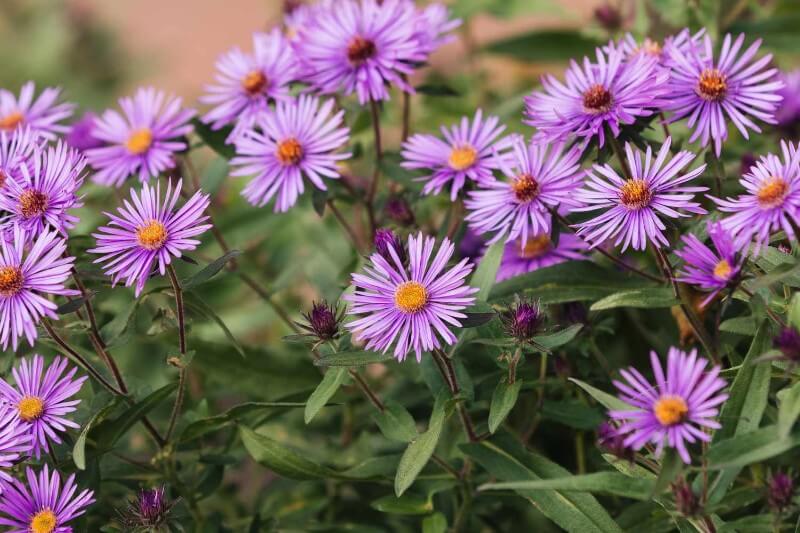
The Aster, a perennial from the Aster spp., is a celestial mimic with its star-like flowers that close out the blooming season with a flourish. Native to North America, these hardy plants symbolize the changing of seasons as they decorate the landscape with their vivid blossoms from late summer to fall.
With colors spanning the spectrum from deep purples to pinks and a brilliant white, Asters are not just a visual treat; they are also a critical food source for pollinators preparing for the winter. Their daisy-like appearance, with a central disc surrounded by petal-like rays, offers one last hurrah of color and life in gardens as other flowers begin to fade.
| Family | Appearance | Origin | Blooming Season | Growth Habit | Size |
| Asteraceae | Daisy-like flowers with a central disc and surrounding petals in various colors. | North America | Late Summer-Fall | Perennial | 1-6 ft tall |
Asters thrive in well-drained soil with good sun exposure. They are adaptable and can tolerate a range of soil types, making them a favorite for both novice and experienced gardeners. Asters are generally low-maintenance but can benefit from occasional pruning and division to maintain their vigor and bloom quality.
As the days shorten and the nights grow cool, the Aster stands resilient, offering its nectar to the last of the season’s butterflies and bees. Its presence is a beautiful reminder of nature’s cycles and the bounty that autumn brings.
Alstroemeria: The Peruvian Lily’s Flourish
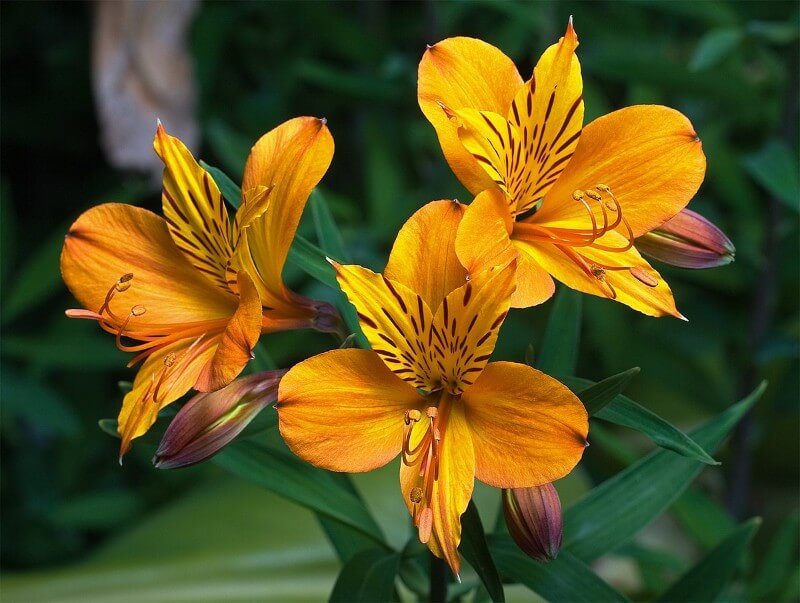
The Alstroemeria, often known as the Peruvian Lily or Lily of the Incas, is a flower that embodies the vibrant spirit of its South American roots. Part of the Alstroemeria spp., this plant is cherished for its clusters of lily-like blooms that burst forth in a riot of color. From the softest pastels to the most intense oranges, pinks, and purples, the flowers of the Alstroemeria bring a touch of exotic flair to gardens and bouquets alike.
Alstroemerias bloom from summer into fall, providing a long-lasting display of speckled and streaked petals that seem to capture the essence of a painter’s palette. These perennials are not just visually stunning; they are also robust, often resisting the pests and diseases that can plague other garden favorites.
| Family | Appearance | Origin | Blooming Season | Growth Habit | Size |
| Alstroemeriaceae | Clusters of lily-like blooms in a wide range of colors, often speckled or streaked. | South America | Summer-Fall | Perennial | 1-3 ft tall |
Alstroemerias are known for their resilience and their ability to adapt to various soil conditions, though they do prefer a sunny or partly shaded spot with well-drained soil. They are relatively low maintenance, requiring occasional watering during dry spells and a little extra care to ensure they do not become too crowded in their beds or borders.
Gardeners often prize Alstroemerias for their long stems and lengthy vase life, making them a go-to choice for cut flowers. Their presence in a floral arrangement is always striking, adding both volume and a splash of complex color that can complement any composition.
Anemone: Whispers of Myth and Beauty
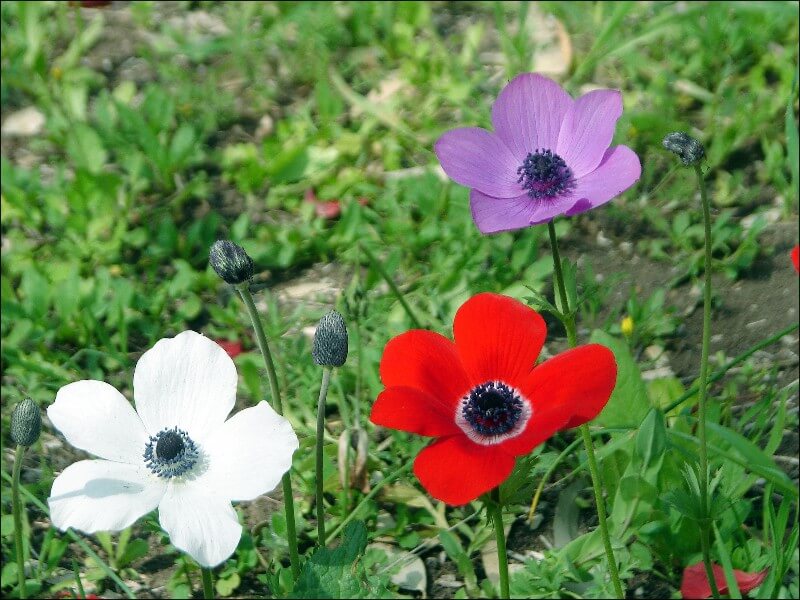
The Anemone flower, a member of the genus Anemone spp., is steeped in myth and graced with a delicate beauty that belies its hardy nature. Known also as windflowers, Anemones are said to have sprung from the tears of Aphrodite as she mourned the death of Adonis, which perhaps explains the wistful beauty of their blooms.
Anemones cover a diverse range of species that flourish in many climates, displaying their charming flowers from the earliest days of spring to the depths of fall. The blooms offer a simple yet profound beauty, typically featuring a single layer of petals surrounding a central, often contrasting, core of stamens.
| Family | Appearance | Origin | Blooming Season | Growth Habit | Size |
| Ranunculaceae | Delicate flowers often with a central core of contrasting stamens. | Global | Spring-Fall | Perennial | 1-3 ft tall |
Anemones prefer well-drained soil rich in organic matter. They thrive in full sun to part shade, depending on the species. Some types, like the spring-blooming wood Anemone, flourish under deciduous trees, where they soak up the sun before the trees leaf out.
Anemones are not just a favorite of gardeners but also of florists, who cherish the flower’s ability to bring a touch of elegance and wildflower charm to any arrangement. They pair beautifully with a variety of other blooms or stand out on their own in a simple vase.
Azalea: The Springtime Symphony
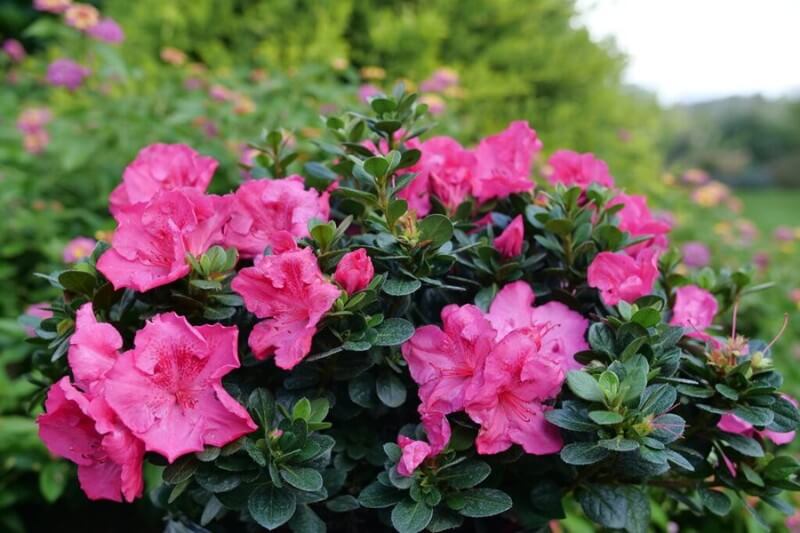
Azaleas, part of the Rhododendron family, are known for their spectacular explosion of colors when they bloom in the spring. Native to Asia and North America, these shrubs are a popular choice for landscapes due to their vibrant clusters of flowers, which can range from deep reds to pastel purples and whites.
While Azaleas are largely celebrated for their ornamental beauty, they are also known for their toxic properties if ingested by pets. Gardeners love Azaleas for their ability to thrive in shady conditions, where other flowers might not flourish.
| Family | Appearance | Origin | Blooming Season | Growth Habit | Size |
| Ericaceae | Vibrant clusters of spring-blooming flowers. | Asia, North America | Spring | Shrub | 1-8 ft tall |
Azaleas prefer acidic, well-drained soil and partial shade to full sun. They require some maintenance, including pruning and protection from pests and diseases, to keep them healthy and blooming beautifully year after year.
Agapanthus: The African Lily’s Grace
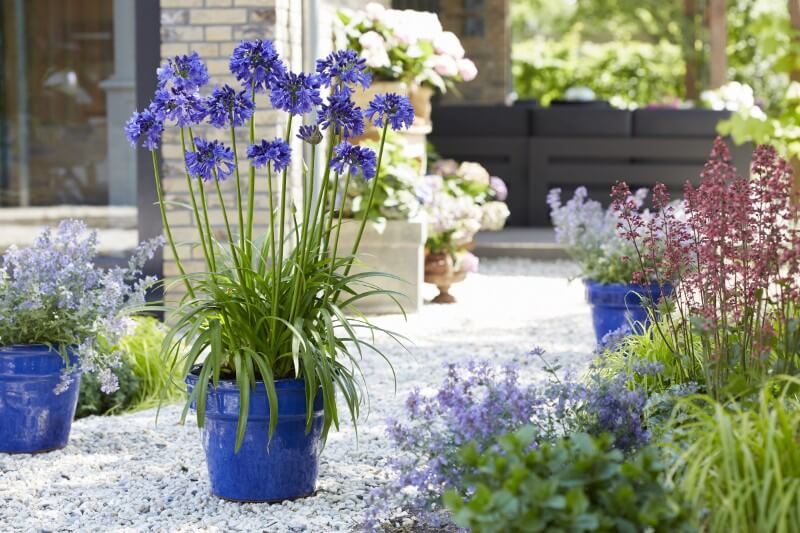
Agapanthus, commonly known as the African Lily, is a genus of flowering plants that feature striking globes of trumpet-shaped flowers perched atop long, slender stems. Native to South Africa, these perennials are revered for their tall, elegant blooms in shades of blue, purple, and white, which sway gracefully above strap-shaped green leaves.
These summer bloomers are often found bordering gardens or gracing containers, where they can bask in the full glory of the sun.
| Family | Appearance | Origin | Blooming Season | Growth Habit | Size |
| Amaryllidaceae | Tall stems topped with globes of trumpet-shaped flowers. | South Africa | Summer | Perennial | 18-24 inches |
Agapanthus thrives in full sun with well-drained soil and can tolerate seaside conditions. They are relatively low-maintenance but do best with regular watering during their growing season and a protective mulch in colder climates.
Allium: The Ornamental Onion’s Allure
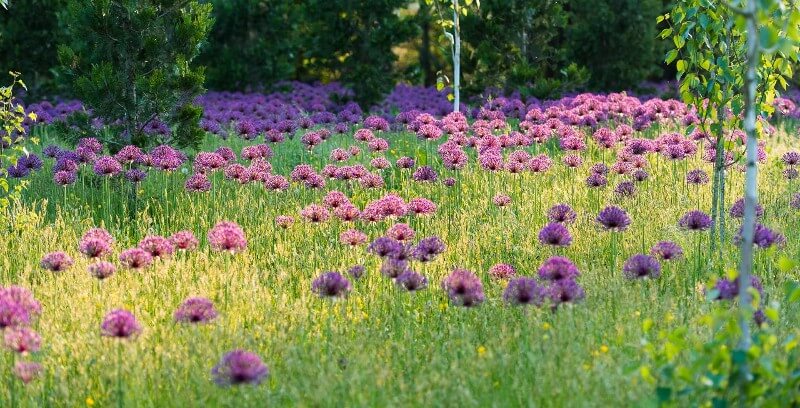
Alliums, also known as ornamental onions, belong to a genus that includes cherished kitchen staples like onions, garlic, and chives. These plants are appreciated in the garden for their spherical blooms that sit like jeweled crowns atop tall, sturdy stalks. Allium flowers range in color from soft pinks to intense purples and are a favorite for adding vertical interest to borders and beds.
Often blooming in late spring to early summer, Alliums are known for their ability to deter garden pests, thanks to their oniony scent, which is subtle but effective.
| Family | Appearance | Origin | Blooming Season | Growth Habit | Size |
| Amaryllidaceae | Spherical blooms atop tall stalks. | Global | Late Spring-Early Summer | Perennial | 1-4 ft tall |
Alliums prefer full sun and well-drained soil. They are very low-maintenance, with most varieties being drought-resistant once established.
Angel’s Trumpet: The Enchanting Herald
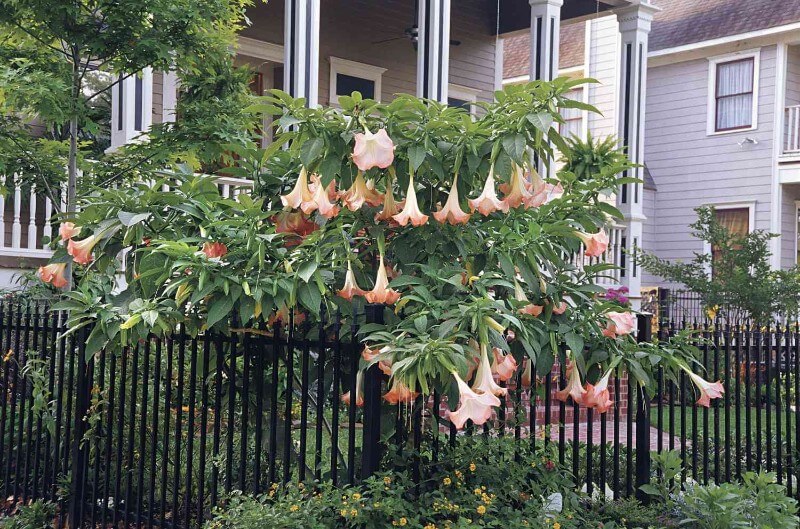
Angel’s Trumpet, known scientifically as Brugmansia, is a genus of seven species of flowering plants with large, pendulous flowers. These stunning blooms resemble trumpets and can emit a pleasing fragrance, especially in the evening. Native to tropical regions of South America, Angel’s Trumpet has been cultivated worldwide for its dramatic flowers and imposing presence.
The plant blooms from late spring to fall, with flowers in shades of white, yellow, pink, and orange.
| Family | Appearance | Origin | Blooming Season | Growth Habit | Size |
| Solanaceae | Large, pendulous, trumpet-shaped flowers. | South America | Late Spring-Fall | Shrub/Tree | 6-20 ft tall |
Angel’s Trumpet thrives in well-drained soil with regular watering and fertilizing. They require full sun to partial shade and need protection from wind and cold temperatures.
African Lily: A Tapestry of Tones in the Summer Garden
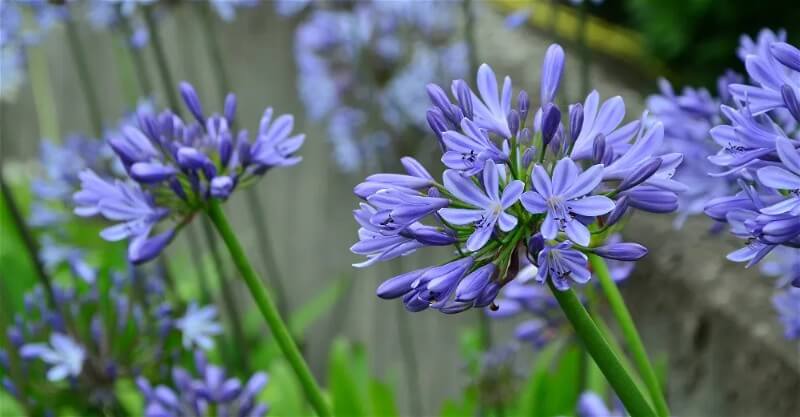
The African Lily, synonymous with the genus Agapanthus, is a testament to the striking elegance that can be found in the simplicity of a flower’s structure. Native to the southern reaches of Africa, these robust perennials are known for their lush foliage and spectacular umbels of blue, violet, or white flowers, which rise above the leaves on tall, statuesque stems.
In bloom, the African Lily is a ballet of blossoms that sway on breezy summer days, each individual flower a delicate trumpet calling to a host of pollinators. The plant’s ability to thrive in a range of conditions, from the sun-soaked borders to the dappled shade of a patio setting, makes it a versatile choice for gardeners.
| Family | Appearance | Origin | Blooming Season | Growth Habit | Size |
| Amaryllidaceae | Spherical clusters of trumpet-shaped flowers atop long stems. | South Africa | Summer | Perennial | 18-24 inches |
The African Lily prefers a sunny spot in the garden, with soil that provides good drainage yet retains enough moisture to sustain its lush growth. While tolerant of a degree of drought once established, the plant performs best when watered regularly during the growing season.
African Lilies are often used in ornamental landscaping for their structural beauty and the long-lasting nature of their blooms. When cut, the flowers can be a stunning addition to bouquets, bringing a piece of the African sun to the art of floral arrangement.
Aquilegia: The Graceful Columbine
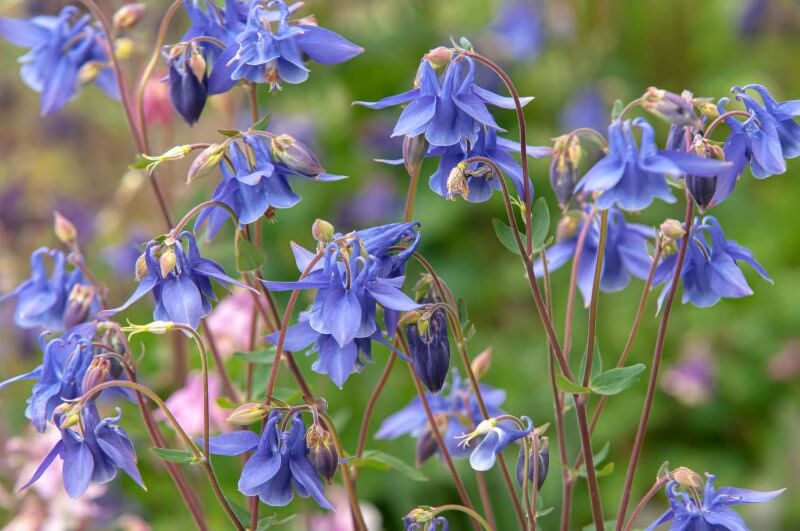
Aquilegia, known fondly as Columbine, is a genus of airy and delicate perennials that grace woodland and alpine gardens. Famed for their distinctive spurred flowers, they present a whimsical display of intricate blooms in late spring and early summer, with colors ranging from soft blues and pinks to vibrant reds and purples.
These plants carry a sense of old-world charm and fairy-tale whimsy, often attracting hummingbirds and butterflies with their nectar-rich spurs.
| Family | Appearance | Origin | Blooming Season | Growth Habit | Size |
| Ranunculaceae | Spurred flowers with a wide range of colors. | Northern Hemisphere | Late Spring-Early Summer | Perennial | 1-3 ft tall |
Aquilegias thrive in well-drained, fertile soil and enjoy a position in full sun or partial shade. They self-seed readily, which allows their enchanting flowers to return year after year, often surprising gardeners with new colors and forms.
Anthurium: The Flamingo Flower’s Allure
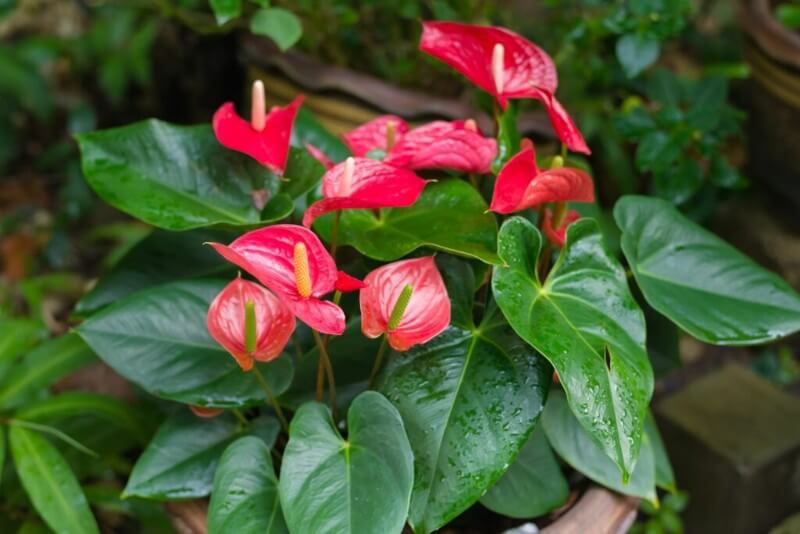
Anthurium, often referred to as the Flamingo Flower, is a genus known for its glossy, heart-shaped spathes and contrasting spadices. These tropical plants are native to the Americas and are renowned for their striking, long-lasting flowers that can be found in hues of red, pink, white, and green.
Anthuriums are not just a favorite for their blooms; their dark, lush foliage also makes them a popular choice for adding a touch of the tropics to indoor spaces.
| Family | Appearance | Origin | Blooming Season | Growth Habit | Size |
| Araceae | Glossy, heart-shaped spathes with a central spadix. | Americas | Year-round | Perennial | 1-3 ft tall |
Anthuriums prefer a warm, humid environment with bright, indirect light. They need well-drained, peat-based soil and should be watered regularly, but allowed to dry slightly between waterings.
Arum Lily: The Majestic Calla
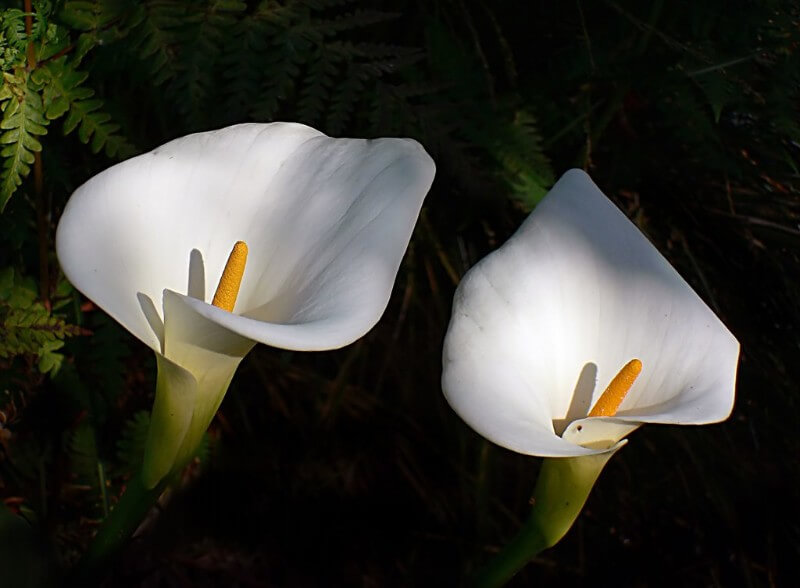
The Arum Lily, also known as the Calla Lily, is a genus that includes Zantedeschia species, known for their elegant, trumpet-shaped spathes and arrow-shaped foliage. These perennials are native to southern Africa and are often associated with purity and beauty.
Arum Lilies are particularly striking in borders, by ponds, or as architectural plants in formal gardens.
| Family | Appearance | Origin | Blooming Season | Growth Habit | Size |
| Araceae | Trumpet-shaped spathes on tall stems. | Southern Africa | Spring-Summer | Perennial | 1-3 ft tall |
Arum Lilies prefer a position in full sun or partial shade and require moist, well-drained soil. While they are somewhat drought-tolerant, they perform best with regular watering during their growth period.
Asphodel: The Meadow’s Ghostly Glow
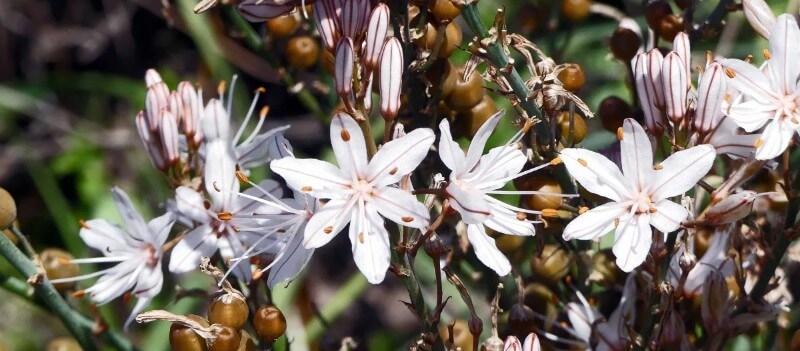
Asphodel, which conjures images of ancient meadows and mythological realms, belongs to a group of plants where the stately Asphodelus stands prominent. In Greek mythology, the Asphodel Meadows was a place for ordinary souls to reside after death, and the flower is often associated with eternal rest and mourning.
These perennial plants display star-shaped flowers on tall spikes, rising above grass-like foliage. The blooms are typically white, lending a spectral elegance to the landscapes they inhabit. Flowering in the warmth of late spring and summer, they are a common sight in the Mediterranean region, adorning meadows, hillsides, and rural gardens.
| Family | Appearance | Origin | Blooming Season | Growth Habit | Size |
| Asphodelaceae | Star-shaped white flowers on tall spikes. | Mediterranean | Late Spring-Summer | Perennial | 1-4 ft tall |
Asphodels thrive in well-drained soil and full sun, mimicking their natural habitat. They are drought-resistant and require little maintenance, making them a favored choice for xeriscaping and sustainable gardens.
Asiatic Lily: The Summer’s Canvas
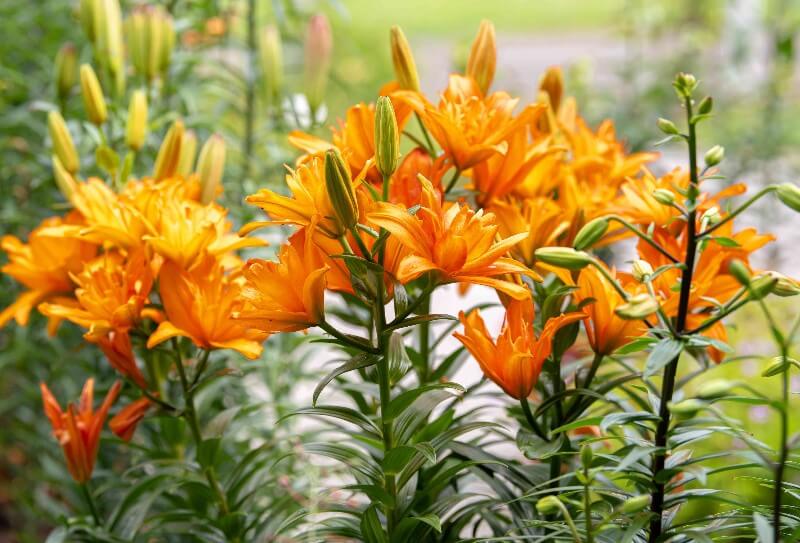
The Asiatic Lily, a member of the Lilium genus, is a popular and versatile perennial known for its large, upward-facing flowers. These lilies come in a brilliant array of colors, from radiant yellows and oranges to deep reds and pinks, often speckled or brushed with contrasting colors.
Asiatic Lilies bloom early in the summer, providing an early burst of color to gardens and landscapes. They do not carry the fragrance of their Oriental counterparts, making them a favorite for those who seek the beauty of lilies without the accompanying scent.
| Family | Appearance | Origin | Blooming Season | Growth Habit | Size |
| Liliaceae | Large, colorful, upward-facing flowers. | Asia | Early Summer | Bulb | 1-6 ft tall |
Asiatic Lilies prefer full sun to part shade and require well-drained soil rich in organic matter. They are relatively easy to grow, making them suitable for beginner gardeners, and their bulbs can be divided and replanted to propagate the plants.
Aztec Lily: The Resplendent Sprekelia
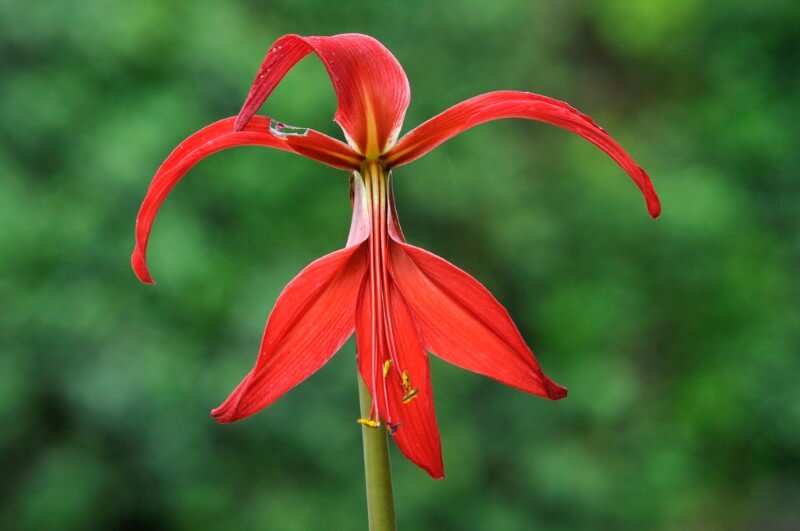
The Aztec Lily, known scientifically as Sprekelia formosissima, is a flower of dramatic flair and striking beauty. Often mistaken for an orchid due to its ornate petals, the Aztec Lily is actually a member of the Amaryllidaceae family. It is indigenous to the rocky outcrops of Mexico, where its crimson-red blooms have been admired since the time of the Aztecs.
This bulbous plant unfurls its singular, velvety flowers in late spring or early summer, each one an intricate display resembling an exotic tropical bird. The Aztec Lily’s blooms are indeed a rare visual feast, with each petal taking its own distinct form to create a harmonious whole.
| Family | Appearance | Origin | Blooming Season | Growth Habit | Size |
| Amaryllidaceae | Dramatic red flowers resembling a tropical bird. | Mexico | Late Spring-Early Summer | Bulb | 1-2 ft tall |
Aztec Lilies thrive in well-drained soil with moderate moisture. They prefer a sunny location but appreciate some afternoon shade in hotter climates. These plants are often grown in containers where their striking appearance can be showcased as a living piece of art.
Australian Violet: The Hardy Groundcover
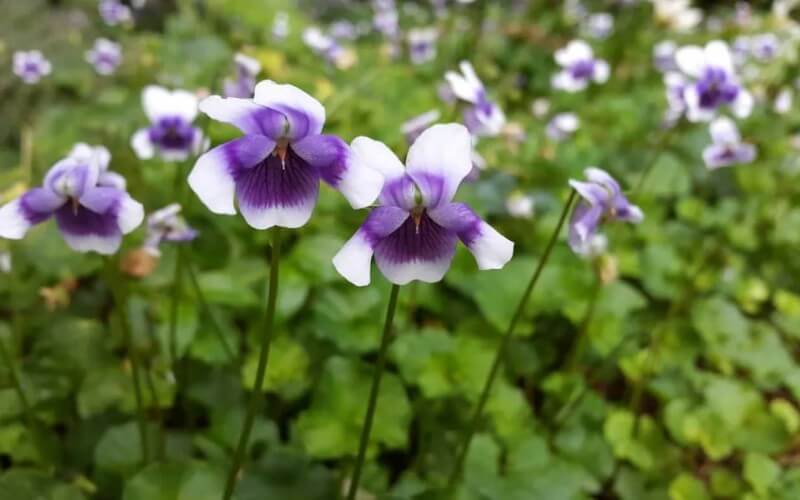
The Australian Violet, Viola hederacea, is a charming groundcover native to Australia and known for its resilience and delicate beauty. It bears small, heart-shaped leaves and dainty flowers that can range in color from white to pale lilac, with a burst of yellow at the center.
This evergreen perennial is as tough as it is beautiful, spreading eagerly to form a dense mat that can thrive in a variety of conditions, including shady and moist areas where other plants may struggle.
| Family | Appearance | Origin | Blooming Season | Growth Habit | Size |
| Violaceae | Small, heart-shaped leaves with white to lilac flowers. | Australia | Year-round | Perennial | Groundcover |
Australian Violets are ideal for underplanting beneath trees and shrubs or for stabilizing soil in sloped gardens. They prefer moist, well-drained soil and can tolerate both full sun and heavy shade, making them a versatile addition to any garden.
Angelonia: The Summer Snapdragon
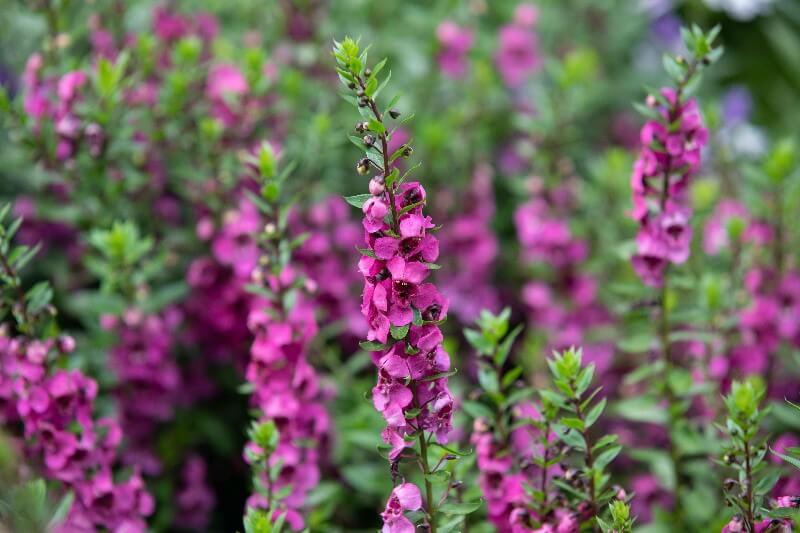
Angelonia, often dubbed the ‘Summer Snapdragon’ due to its resemblance to snapdragons, is a standout in the heat of the summer garden. This robust perennial, part of the Angelonia genus, is treasured for its spires of delicate, orchid-like flowers that come in shades of purple, blue, pink, and white.
Flourishing even in the swelter of summer, Angelonia sends up its cheerful spires that not only add vertical interest but also a gentle, sweet fragrance to the garden air. It is a favorite among gardeners for its drought resistance and its continuous blooming throughout the season without the need for deadheading.
| Family | Appearance | Origin | Blooming Season | Growth Habit | Size |
| Plantaginaceae | Spikes of delicate, orchid-like flowers. | Central and South America | Summer | Perennial | 1-2 ft tall |
Angelonia thrives in full sun and can handle high humidity and dry conditions once established. It’s an excellent choice for borders, containers, or as a groundcover, where its continuous flowering can be fully appreciated.
Ageratum: The Floss Flower’s Charm
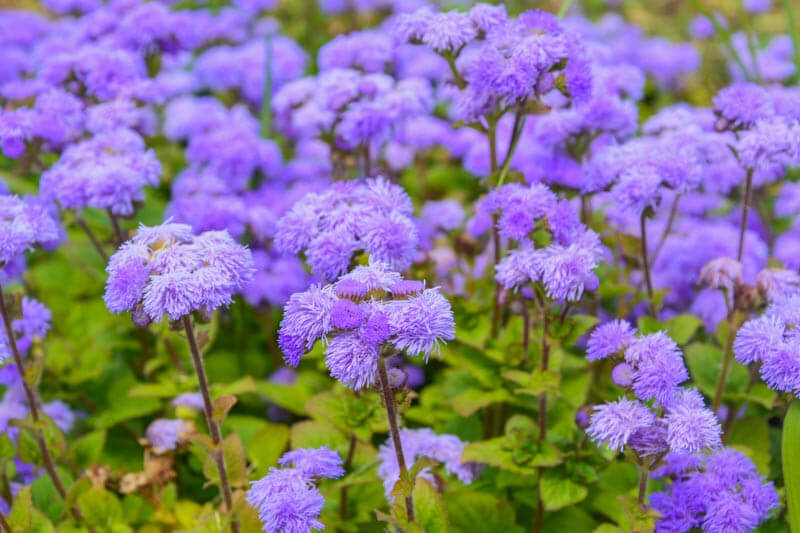
Ageratum, known commonly as the Floss Flower, is a fluffy annual beloved for its tufts of soft, brush-like flowers. The most familiar shades of Ageratum are in the spectrum of blues—a rarity in the floral world—but they can also be found in hues of pink, white, and purple.
With a bloom period that extends from late spring to frost, Ageratums contribute a cloud-like softness to the garden landscape. They are particularly valued for their ability to attract butterflies and other beneficial insects.
| Family | Appearance | Origin | Blooming Season | Growth Habit | Size |
| Asteraceae | Fluffy, brush-like flowers in various colors. | Central America, Mexico | Late Spring-Frost | Annual | 6-18 inches |
Ageratums prefer full sun to partial shade and flourish in rich, well-drained soil. They’re often planted en masse for a striking display in garden beds or borders and are also popular in containers and hanging baskets.
African Daisy: The Sun’s Reflection in Petals
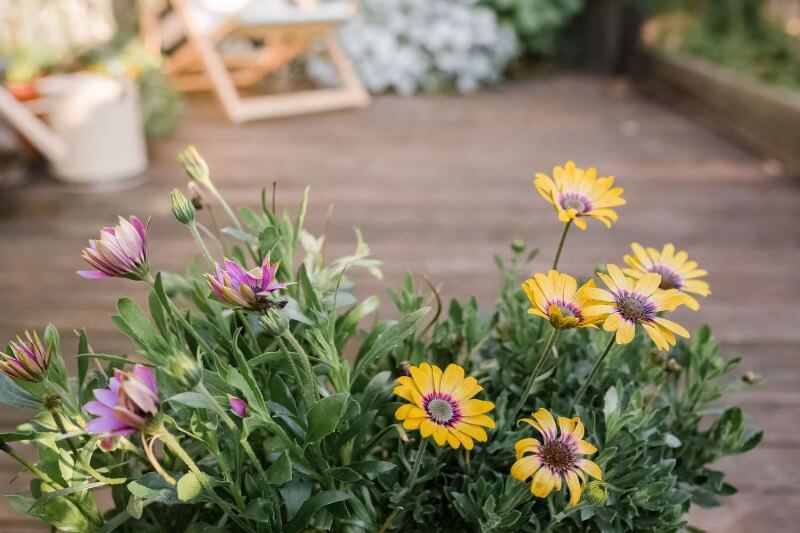
The African Daisy, or Osteospermum, is a vibrant canvas of color, a cheerful perennial that mirrors the sunny landscapes of Africa. Its daisy-like flowers come in a kaleidoscope of shades, including purples, pinks, blues, whites, and yellows, often with a striking blue center that seems to gaze up at the sky.
This hardy plant bursts into a cornucopia of color in the spring and continues to flower into the autumn, offering a long-lasting display that can adapt and thrive in a variety of conditions. The African Daisy is not just a feast for human eyes; it’s also a banquet for pollinators, drawing in bees and butterflies with its open-faced blooms.
| Family | Appearance | Origin | Blooming Season | Growth Habit | Size |
| Asteraceae | Daisy-like flowers with a distinctive blue center. | South Africa | Spring-Autumn | Perennial | 6 inches to 2 ft tall |
African Daisies are known for their love of the sun and can endure even in poor soil conditions, making them a robust choice for gardeners. They prefer well-drained soil and should be watered moderately but consistently during dry periods.
Ajuga: The Carpet of the Forest Floor
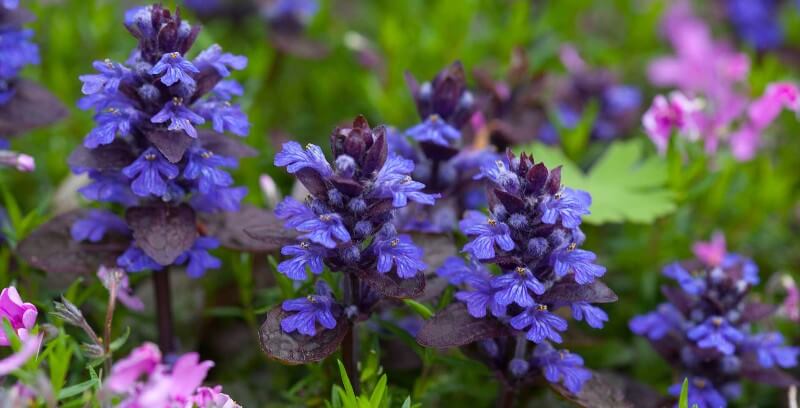
Ajuga, also known as Bugleweed, is a genus that forms luscious carpets of foliage with its glossy leaves and spiky flowers. This ground-hugging perennial is a gardener’s ally for filling gaps with its dense mats, often boasting shades of green, bronze, or purple. When spring arrives, Ajuga bursts into life with towers of blue, violet, pink, or white flowers, transforming garden floors into a vibrant spectacle.
| Family | Appearance | Origin | Blooming Season | Growth Habit | Size |
| Lamiaceae | Glossy foliage and spiky flowers in various colors. | Europe, Asia, Africa | Spring | Perennial | 6-10 inches |
Thriving in both sun and shade, Ajuga is a low-maintenance solution for challenging garden spots. It’s a favorite in landscape design not only for its beauty but also for its ability to outcompete weeds, making it a practical choice for gardeners seeking both form and function.


